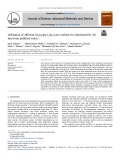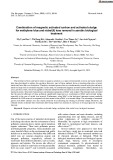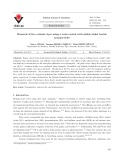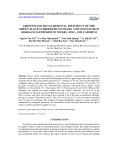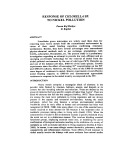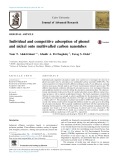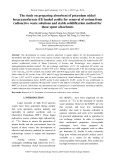
Removal of nickel
-
Toxic metals in water systems pose a global health risk. Thus, multifunctional water monitoring and treatment materials are indispensable. Nickel ions, a frequent heavy metal pollutant, affect ecosystem function. This study investigates the utilization of Al2O3@g-C3N4 (AlCN) nanosorbent for adsorbing Ni (II) ions from aqueous solutions.
 9p
9p  visergeyne
visergeyne
 18-06-2024
18-06-2024
 0
0
 0
0
 Download
Download
-
In this study, we synthesized magnetic activated carbon (MAC) derived from Litsea glutinosa seeds, which was applied to eliminate methylene blue and nickel ions in the aeration tank of the biological treatment system. Structural characteristics and adsorption properties of MAC were studied. The obtained results revealed that the removal efficiency of these pollutants significantly improved as a combination of MAC and activated sludge, especially in the case of nickel ions removal.
 7p
7p  dianmotminh02
dianmotminh02
 03-05-2024
03-05-2024
 2
2
 1
1
 Download
Download
-
The preconcentration of metal ions present at low concentration levels in aqueous systems and the selective removal of potentially toxic metals are important applications of adsorption processes. In this study, a heptadentate dinucleating ligand was anchored to chitosan for use in adsorption studies on Zn(II), Cu(II) and Ni(II) ions.
 8p
8p  viginny
viginny
 30-12-2022
30-12-2022
 3
3
 2
2
 Download
Download
-
Resins coated with nickel/nickel boride nanoparticles were used to remove brilliant green, methyl violet, methylene blue, phenosafranine, and brilliant cresyl blue from water. The effects of pH, adsorbent dose, contact time, and initial dye concentration on the adsorption efficiencies were investigated. The point of zero charge for the adsorbent was pH 9.5. Isotherm studies were conducted using Langmuir, Freundlich, and Dubinin–Radushkevich models, and thermodynamic studies were also performed. Adsorption of the five dyes was found to obey the Langmuir isotherm model and was endothermic.
 15p
15p  tudichquannguyet
tudichquannguyet
 29-11-2021
29-11-2021
 25
25
 1
1
 Download
Download
-
In wastewater treatment, scientific and practical models utilizing numerical computational techniques such as artificial neural networks (ANNs) can significantly help to improve the process as a whole through adsorption systems. In the modeling of the adsorption efficiency for heavy metals from wastewater, some kinetic models have been used such as pseudo first-order and second-order. The present work develops an ANN model to forecast the adsorption efficiency of heavy metals such as zinc, nickel, and copper by extracting experimental data from three case studies.
 20p
20p  tudichquannguyet
tudichquannguyet
 29-11-2021
29-11-2021
 10
10
 1
1
 Download
Download
-
A review of the studies dealing with the removal of chromium, cadmium, and nickel ions with different adsorbents published in the literature between 2014 and 2018 is given in tabular form, along with the adsorption conditions, adsorption isotherm, and kinetic models applied by the authors to model the experimental data and adsorption capacities. The review focuses on the efficiency of ion removal.
 25p
25p  tudichquannguyet
tudichquannguyet
 29-11-2021
29-11-2021
 8
8
 1
1
 Download
Download
-
Heavy metal contamination is among the globally environmental and ecological concerns. In this study we assessed the development of the two green algae Schroederia setigera and Selenastrum bibraianum under exposures to 5 - 200 µg/L of Ni, Zn, and Cd in the laboratory conditions. Heavy metal removal efficiency of S. setigera was also tested in 537 µg Ni/L, 734 µg Zn/L, and 858 µg Cd/L. We found that the exposures with these heavy metals caused inhibitory on the growth of S. bibraianum.
 11p
11p  cothumenhmong9
cothumenhmong9
 04-01-2021
04-01-2021
 12
12
 1
1
 Download
Download
-
The present study is a preliminary investigation regarding an attempt to provide low cost, efficient and an emerging eco-friendly technology for the removal of nickel from the nickel polluted environment by the use of wild type Chlorella Sp.
 11p
11p  dayhoctainha
dayhoctainha
 10-09-2020
10-09-2020
 18
18
 1
1
 Download
Download
-
Agricultural waste has received much attention for its potential of being efficient and low-cost adsorbents to remove heavy metals from water. This paper presents a batch investigation of the potential of an adsorbent produced from coffee bean husk for removing copper, nickel and zinc ions from aqueous solution. At the initial pH of 5.0, a dose of 10 g/L, initial concentration of 50 mg/L, shaking speed of 100 rpm, particle size of 0.
 7p
7p  angicungduoc5
angicungduoc5
 13-06-2020
13-06-2020
 8
8
 0
0
 Download
Download
-
Individual and competitive adsorption studies were carried out to investigate the removal of phenol and nickel ions by adsorption onto multiwalled carbon nanotubes (MWCNTs). The carbon nanotubes were characterized by different techniques such as X-ray diffraction, scanning electron microscopy, thermal analysis and Fourier transformation infrared spectroscopy. The different experimental conditions affecting the adsorption process were investigated. Kinetics and equilibrium models were tested for fitting the adsorption experimental data.
 11p
11p  trinhthamhodang1
trinhthamhodang1
 16-11-2019
16-11-2019
 10
10
 0
0
 Download
Download
-
Nowadays, wastewater from various industries contains a large number of harmful heavy metals and coloring agents, which have to be removed to restore the quality of the environment. In this study, the removal of nickel ions (Ni2+) and methylene blue (MB) from the aqueous solution using steel slag as a low cost adsorbent was investigated. The chemical and mineralogical compositions, as well as the surface area of slag, were analyzed by using X-ray fluorescence spectroscopy, X-ray diffraction, and the Brunauer-Emmett-Teller method (BET).
 7p
7p  caygaocaolon1
caygaocaolon1
 13-11-2019
13-11-2019
 31
31
 1
1
 Download
Download
-
The development of cesium selective adsorbent is urgent subject for the decontamination of intermediate and high level water from nuclear facilities especially in nuclear accidents. For the selective adsorption and stable immobilization of radioactive cesium, K-Ni- hexacyanoferrate (II) loaded zeolite (FCzeolite) (synthesized zeolite of Hanoi University of Science and Technology) were prepared by impregnation/precipitation method.
 9p
9p  vineptune2711
vineptune2711
 04-11-2019
04-11-2019
 12
12
 0
0
 Download
Download
-
Activated carbon (AC) has been proven to be an effective adsorbent for the removal of a variety of pollutants. AC is extensively used for adsorption because its high surface area is welldeveloped internal micro porosity. The objective of this study is to determine the optimal condition of the surface modification process of activated carbon from rice husk (ACRH) using HNO3.
 8p
8p  cumeo3000
cumeo3000
 01-08-2018
01-08-2018
 37
37
 1
1
 Download
Download
-
I was looking at Inco – a nickel-mining company – about a year ago. It had outstanding numbers, including a low price-to-earnings ratio (P/E), big margins, and a good cash flow. So – after doing my research into the company’s growth strategy and management team – I recommended it to my subscribers. It’s now up over 80%. What did I know that other investors missed? It’s pretty simple. I knew that mining companies are sometimes discounted because their industry is so cyclical. What’s more, the price of the commodities they extract can also be volatile.
 19p
19p  giacmongdevuong209
giacmongdevuong209
 05-02-2013
05-02-2013
 51
51
 4
4
 Download
Download
CHỦ ĐỀ BẠN MUỐN TÌM








